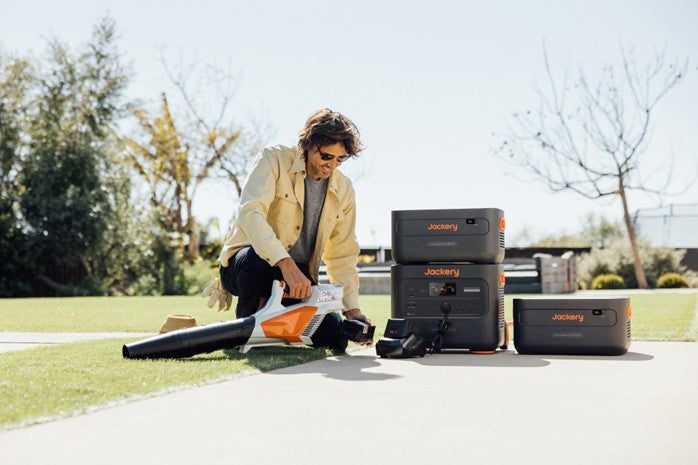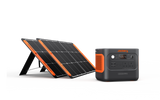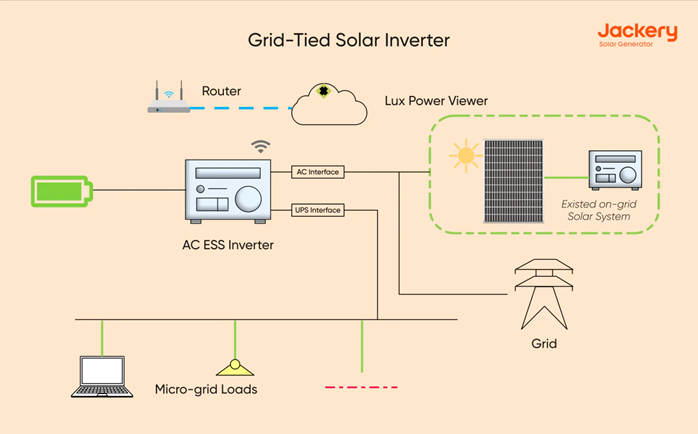Off-Grid Inverter: What Is, Pros & Cons, Off-Grid Vs On-Grid Inverter
If you've ever wanted to live off the grid, you've probably come across three popular solar systems: on-grid, off-grid, and grid-tied generators. While all these types of solar generators have different working principles, they have one thing in common: a built-in inverter.

The core purpose of the inverter is to convert DC to AC power, which is then supplied to electrical appliances. Jackery Explorer Portable Power Stations feature a pure sine wave inverter that takes the DC electricity from the solar power panels and converts it into AC power.
In this guide, we will reveal what an off-grid inverter is and how it compares to an on-grid inverter.
|
Products |
Image |
Capacity |
Rated / Peak Power |
Battery |
Size |
|
Solar Generator 2000 Plus |
 |
2-12 kWh |
3000W Max/ 6000W Surge Peak |
LiFePO4 |
Height: 14.1 in (35.94 cm) Width: 18.6 in (47.3 cm) Length: 14.7 in (37.36 cm) |
|
Solar Generator 1000 Plus |
 |
1.25-5 kWh |
2000W/ 4000W Surge Peak |
LiFePO4 |
Height: 11.14 in (28.3 cm) Width: 10.24 in (26 cm) Length: 14 in (35.6 cm) |
What Is An Off-Grid Inverter?
Solar inverter is a crucial component that converts the electrical energy produced by PV panels into AC power that can then be utilized to charge appliances. Off-grid solar inverters, also called standalone inverters, are compatible with off-grid solar systems. As the name defines, these inverters operate independently from the grid. Thus, they make an excellent choice for someone living in remote locations.
What Are The Pros & Cons of Off-Grid Inverter?
Off-grid inverters seem synonymous with energy autonomy and resilience. They can be used in isolated areas where there is no nearby access to the electricity grid. Here are some of the pros and cons of off-grid inverters.
Pros
- Off-grid inverters are standalone power sources that can provide continuous power, even during brownouts or blackouts.
- The off-grid systems work without connection to utility grids, which makes them more cost-effective in the long run.
- Solar generators with built-in inverters reduce your reliance on fossil fuels, contributing to a sustainable and greener future.
Cons
- The off-grid solar systems have high initial costs.
- There should be a continuous energy supply to backup batteries or power stations.
What Are The Features of Off-Grid Inverter?
Off-grid inverters have multiple features, which help improve the lifespan of batteries in the long run.
LDC: It helps you understand the functions of the off-grid inverter, including power consumption details, real-time power generation analysis, battery charging status, and reason for inverter issues.
Overload and Short Circuit Protection: This protects the battery from short circuits and excess loads, ensuring the battery's longevity.
Battery Charging Control: The function optimizes the battery charging and ensures it is efficiently charged without any damage. When there is an appropriate supply of electricity to the battery, this eventually extends the battery life and ensures optimal performance.
Automatic Voltage Regulation: With this feature, the off-grid inverters ensure the AC output voltage is stable and free of fluctuation. This provides a consistent and steady electricity supply to appliances.
Remote Monitoring: This feature monitors the performance of the off-grid inverter with the help of mobile devices or a computer.
Off-Grid Inverter Vs. On-Grid Inverter
An off-grid solar system offers complete independence from the electricity grid, as it does not rely on any power source except the sun. On the contrary, a grid-tied solar system remains partially dependent on the sun and partially on the local utility supply grid. Let's explain the off-grid vs on-grid solar system.
Grid-Tied Solar System
Also called on-grid systems, this charging solution is one of the most popular and common among homeowners and businesses. The system is connected to the local electricity grid and solar generator to deliver as much energy as you need.
The system is made up of two essential components:
- Grid-tie inverter (GTI) or microinverters
- Power meter

Grid-tied solar systems are budget-friendly options since they do not require an expensive battery.
Pros
- Grid-tied solar systems help you save more money because they do not require batteries.
- You can sell the excess power to utilities or electricity grids to generate additional revenue.
- These systems have low installation costs and require less maintenance.
Cons
- The grid-tied solar system automatically shuts down during power outages.
- They are not wholly grid-independent.
Off-Grid Solar System
Off-grid systems are entirely independent from power utility grids and rely solely on the sunlight. The system is complicated and more expensive but seems cost-effective in the long run.
Unlike on-grid or grid-tied systems, the off-grid solar system is made up of the following components:
- Solar charge controller
- Off-grid inverter
- Battery bank
- DC disconnect (additional)
- Backup generator (other)

The system runs exclusively on solar power and has no connection with the electricity grid. Investing in an off-grid inverter might be a good idea if your area gets enough sunlight.
Pros
- The solar system lets you store abundant sun's energy in the battery.
- You do not have to pay for electricity grids as the system is no longer tied to the grid.
- The off-grid solar generator supplies electricity even during a power failure or an outage.
Cons
- The battery may not be fully recharged if the area does not get enough hours of peak sunlight.
- The off-grid system can be costly to purchase.
When deciding between on-grid or off-grid systems, you'll need to understand a few crucial factors like your budget, location, and, most importantly, energy needs. For example, if you live in an area that receives enough hours of sunlight, you may benefit from an off-grid solar inverter system.
|
|
Off-Grid Inverter |
On-Grid Inverter |
|
Pros |
- Works on solar energy - No connection with the electricity grid - Works well during power outages |
- Less costly compared to off-grid systems - Net metering is available to sell additional energy-generated - Low installation costs |
|
Cons |
- High initial cost - High maintenance costs |
- Automatically shuts down during power outages - No external battery backup to store the extra energy |
|
Working Principles |
Off-grid solar systems work by converting energy from solar power panels and storing it in a battery backup. |
The on-grid system starts with solar panels that convert sunlight into DC. The inverter in the system turns DC into AC, which is then supplied to the switchboard to charge appliances. |
Jackery Solar Generators: Portable Off-Grid Solar Solutions
Many off-grid solar systems are heavy and involve a high initial cost. However, that's not the case with Jackery Solar Generators. These solar generators combine Jackery SolarSaga Solar Panels that collect and convert the sun's energy into electricity and Jackery Explorer Portable Power Stations that store and supply electricity to appliances.

Here are some popular solar generators that can help you charge home or outdoor appliances for long hours.
Jackery Solar Generator 2000 Plus
The Jackery Solar Generator 2000 Plus is a large-capacity solar system that can be expanded from 2kWh to 12kWh. It supports ultra-fast charging and can be recharged in only 2 hours. The outstanding LiFePO4 battery can charge 99% of electrical devices during power outages.

Customer Review
"Purchased the Jackery Solar Generator 2000 Plus for working on my off-grid cabin and to power the cabin when I'm not working on it. Has worked great running full-size table saw, radial arm saw, air compressor, and more." — Timothy W.
|
Product |
Solar Generator 2000 Plus |
|
Capacity |
2042.8Wh |
|
Cycle Life |
4000 cycles to 70%+ capacity |
|
Dimension |
Height: 14.1 in (35.94 cm) Width: 18.6 in (47.3 cm) Length: 14.7 in (37.36 cm) |
|
Recharging Methods |
AC Adapter: 2 Hours Car Adapter: 25 Hours 2*SolarSaga 200W Solar Panels: 7 Hours 6*SolarSaga 200W Solar Panels: 2 Hours |
|
Output Ports |
AC Output (×4):120V~ 60Hz, 20A Max AC Output (×1):120V~ 60Hz, 25A Max USB-A Output (x2): Quick Charge 3.0, 18W Maximum USB-C Output (x2): 100W Maximum, (5V, 9V, 12V, 15V, 20V up to 5A) |
|
Working Hours |
Coffee Maker (800W): 2.1H Electric Cooker (900W): 1.9H Portable Air Conditioner (1000W): 1.7H TV (60W): 29H Microwave Oven (1050W): 1.6H Drone (90W): 19.2H Kettle (850W): 2H Electric Grill (850W): 2H |
Jackery Solar Generator 1000 Plus
With a battery capacity of 1264Wh and a massive 2000W output, the Jackery Solar Generator 1000 Plus supports 99% of your home appliances. The LiFePO4 battery also supports three add-on battery packs to expand its capability and capacity to 5kWh.

|
Product |
Solar Generator 1000 Plus |
|
Capacity |
1264.64Wh |
|
Cycle Life |
4000 cycles to 70%+ capacity |
|
Dimension |
Height: 11.14 in (28.3 cm) Width: 10.24 in (26 cm) Length: 14 in (35.6 cm) |
|
Recharging Methods |
AC Adapter: 1.7 Hours Car Adapter: 7 Hours 4*SolarSaga 100W Solar Panels: 4.5 Hours 6*SolarSaga 200W Solar Panels: 2 Hours |
|
Output Ports |
AC Output (x3): 120V~60Hz, 2000W (4000W Peak) USB-A Output (x2): 18W Max, 5-5V⎓3A USB-C Output (x2): 100W Maximum, (5V, 9V, 12V, 15V, 20V up to 5A) |
|
Working Hours |
Coffee Maker (800W): 1.3H Electric Cooker (900W): 1.2H Portable Air Conditioner (1000W): 1H TV (60W): 18H Microwave Oven (1050W): 1H Drone (90W): 12H Kettle (850W): 1.2H Electric Grill (850W): 1.2H |
How to Size An Off-Grid Inverter?
The maximum continuous output, together with the surge power of an inverter, is measured in watts. This affects the sum of all the AC loads that can be operated using the inverter at the same time. The most crucial factor determining the best off-grid inverter's size is peak power consumption.
In order to size an inverter, you'll need to add the power consumption of all the appliances you want to operate at once. If the electrical devices include induction motors like dryers, large power tools, dishwashers, etc., be sure to add the starting watts required.
Here is an example:
First, you'll need to list the appliances you wish to power, like lights (5W), coffee maker (800W), and refrigerator (1000W). The total wattage required will be 1805W.
Secondly, you'll need to choose a solar generator supplying more than 1805W of power. Let's say you select Jackery Solar Generator 2000 Pro with a battery capacity of 2160Wh.
Working Time = Capacity in Wh × 0.85 / Operating wattage of the appliances = 2160Wh * 0.85 / 1805W = 1H.
Final Thoughts
Off-the-grid solar systems are becoming more and more popular, especially in remote areas where there's no access to electricity grids. In fact, people looking to live a sustainable and eco-friendly lifestyle choose off-grid inverter or solar systems.
Jackery Solar Generators have a high battery capacity and include a pure sine wave inverter for better performance. The small solar generators are lightweight and can power most outdoor appliances, whereas the larger Jackery Solar Generators feature wheels and handles that make them easy to carry from one place to another and charge home appliances.


























































































